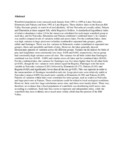| dc.identifier.citation | A. O. Owino, J. O. Oyugi, O. O. Nasirwa and L. A. Bennun (2001). Patterns of variation in waterbird numbers on four Rift Valley lakes in Kenya, 1991–1999. Hydrobiologia August 2001, Volume 458, Issue 1-3, pp 45-53 | en |
| dc.description.abstract | Waterbird populations were censused each January from 1991 to 1999 at Lakes Naivasha, Elmenteita and Nakuru and from 1992 at Lake Bogoria. These shallow lakes in the Kenyan Rift Valley fluctuate greatly in water level and alkalinity. All but Naivasha are usually saline; Nakuru and Elmenteita at times support fish, while Bogoria is fishless. A standardized logarithmic index of relative abundance (value 1.0 for the mean) was calculated for each major waterbird group at each lake, and for Naivasha, Elmenteita and Nakuru combined (‘combined lakes’). Its variance was used to compare levels of variation within and across lakes. For the combined lakes, there was high variance in large piscivores (whether combined or separated into groups), grebes, rallids and flamingos. There was low variance in Palaearctic waders (combined or separated into groups), ibises and spoonbills and birds of prey. However, the lakes generally showed idiosyncratic patterns of variation across the different groups. Variance in the indices for birds of prey and kingfishers were consistently low (max. 0.036 and 0.042, respectively), but no group had consistently high variance across all sites. The variance for all birds (other than flamingos) combined was low (0.018 – 0.085) and similar across all lakes and for combined lakes (0.018). For the combined lakes, the variance for flamingos was five times higher than for all other birds (p<0.05), though the two variances were almost equal for Bogoria. Flamingos were the most variable at Naivasha (variance 0.281) followed by Elmenteita (0.177), Nakuru (0.101) and Bogoria (0.024, and significantly lower than all the rest, p<0.05). This was opposite in order to the mean numbers of flamingos recorded at each site. Large piscivores were relatively stable at Naivasha (variance 0.005) but much more variable at Elmenteita (0.199) and Nakuru (0.269). Patterns of variation within lakes were correlated for some groups, such as waders at Naivasha and large piscivores at Nakuru. These correlations could be related to local ecological conditions. However, there were few large correlations across sites, and these were mainly direct. There was, therefore, no evidence that a fixed population of waterbirds was distributing itself across sites according to conditions. Each lake thus seems to represent and independent entity, while the waterbirds they host evidently move much more widely afield than this portion of the Rift Valley. | en |

